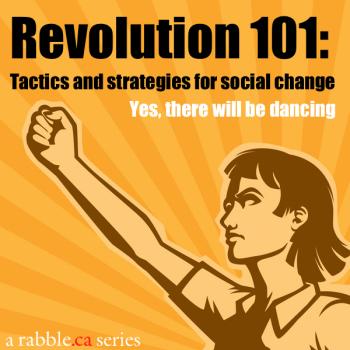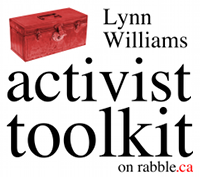In his interview with rabble.ca's Meg Borthwick, Steve D'Arcy spoke about the meaning and importance of militant activism. The idea behind militant activism is not violence or non-violence specifically -- it's about creating a dynamic in a campaign where there is a clear enemy that the campaign is fighting against. As Steve D'Arcy said:
"Militancy is adversarial in the sense that, instead of seeking to find common ground with its targets, it identifies them as adversaries to be defeated or to be forced into retreat."
These campaigns aren't about slow, institutional change created by internal lobbying or compromise. Militant activist campaigns embrace confrontation as a catalyst for change. The goal is not to convince folks in power, but to defeat them by leaving them with no other options. These campaigns, which are often clear-cut and grievance-based, tend to appeal to a vast range of people, many who may not have participated in activist projects before. These campaigns work when the powers that be won't listen to activists.
With enough planning, you can identify a target and put them in a situation where they have limited decisions, all of which are in your favour.
Break down your issue.
Struggles are intersectional, overlapping, complicated, multi-issued and nuanced. A good militant campaign breaks down massive issues into concrete, winnable, community-oriented actions. Start with this primer on cutting an issue into manageable steps. Try using the paper plate challenge activity within your group to break the issue into smaller projects. You want your campaign to be SMART : Specific, Measurable, Achievable, Relevant and Timely.
Choose your target(s).
Figuring out which politicians, institutions and organizations hold the power can be difficult; Powermapping is a tool that can help sort out who is a primary target, who are their influencers and allies, and who can be recruited to work on the campaign against them. Figuring out who has the power to enact change is one thing, creating a strategy that will reach them is another. Once the targets are identified, research everyone involved. Find out as much as possible about previous actions, their stances on issues, what have they responded to in the past and what might work for the future. The goal is to put a reasonable amount of pressure on the targets so that they will be forced by public pressure to do the right thing. You need to know what will make them tick.
Recruit, welcome, repeat.
After powermapping, the scope of a campaign's influence can look a little small in comparison to the vast reach of the target. Don't be discouraged -- get recruiting! The more people involved, the more power the campaign has. Use this workshop to help train recruiters. Reach out to other campaigns around similar issues and start a coalition. This guide to coalition building and this guide to affinity groups are good places to start. Read up on ways to make your campaign welcoming, not just to activists but to folks who may have considered themselves apolitical. Create a solidarity network to strengthen connections between your movement and others.
Be strategic.
You know what your campaign is about, who the target is and how to get to them. The target might have the power in a certain issue, but they should never have power over the outcome of your campaign. Once you go ahead with your action, the target should be between a rock and a hard place -- every option should be in your favour. That's actually not impossible to orchestrate.
For example, if an action is confronting a politician as they leave their office they should have two choices: a) talk to the protesters or b) not talk to the protesters while walking through them. Each option is a bad one for the politician. Speaking to the protesters means they have to acknowledge them and likely be put in a bad light. Not talking to them looks bad as well because they will have to walk through the protesters. There shouldn't be the option of sneaking out the back door. Cover all your bases and plan out a no-win scenario for the target.
A good campaign doesn't begin and end with one action -- look at the bigger picture. How do you want to kick off your campaign? How will you amp up your actions as your campaign grows to put more and more pressure on your target? This workshop activity can help you go from tactic to embracing an overall strategy for your campaign. You can also check out these tools from the Centre for Story Based Strategy to help craft your campaign's narrative.
Take action.
Direct action is a good way to go to stir up conflict, attract media and publicly confront the target. There are so many guides out there about how to plan and execute an effective direct action. Make sure that during the action folks know their legal rights. Try to train legal observers as well as street medics just in case things get out of hand. Don't be afraid to be creative and use humour, theatre or dramatics.
Steff Pinch is the coordinator of the Lynn Williams Activist Toolkit. Find more tools and add your own using your free rabble.ca account on the Activist Toolkit.





Comments
Do
Don't